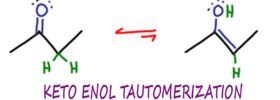Below is the written transcript of my YouTube tutorial video Naming the enyne – Alkene/Alkyne in Same Molecule.
If you prefer to watch it, see Video HERE, or catch the entire Naming Organic Compounds Series.
[Start Transcript]
Leah here from Leah4Sci.com and in this video I will show you how to name a molecule that has both an alkene and an alkyne. Recall that an alkene is a molecule that has a carbon to carbon double bond and gets the last name of “ene” and then alkyne is a molecule that has a carbon to carbon triple bond and gets a last name of “yne”. But how do you name a molecule that has both a double bond and a triple bond? An alkene and alkyne can exist in the same molecule and you prioritize based on where each functional group shows up.
We will use this molecule as our first example. Since I only have one long chain, I highlight my parent chain and then decide how to number. I have the option of numbering from the left giving me a 1 for the double bond or numbering from the right giving me a 2 for the triple bond.
The priority here is determined by which functional group you hit first and so I have to number from the left because I have number 1 which is lower than 2. Having six carbons in my chain gives me a first name of “hex”. Having both a double and a triple bond, I get two last names for this molecule. I get a 1-ene for the double bond and the 4-yne for the triple bond. When it comes to putting the molecule together, “ene” gets a higher priority than “yne” in the naming and that is because in alphabetical order, E comes before Y.
In previous examples, we've shown that you could put the number before the name but because we have two last names here, each number has to precede its specific functional group. This gives me a complete name of hex-1-ene-4-yne. In this example, I switch the order of the substituents so that once again we have a straight chain with an alkene and an alkyne. But in this molecule since the alkyne is terminal, the alkyne gets priority for numbering and so I number starting from the right. Once again six carbons gives me a first name of “hex” and the double bond and triple bond give me a last name of both 1-yne and 4-ene. In this case, even though the triple bond has higher priority for numbering, E comes before Y and so “ene” still comes before “yne” in the name. So the molecule is named hex-4-ene-1-yne.
Now what happens if I have an example that potentially gives the alkene and the alkyne the same name? Once again I start by highlighting my parent chain but now I have the option of numbering from the right giving the triple bond the number 2 or numbering from the left giving the double bond the number 2. In this situation, the alkene has the higher priority than the alkyne and so we start numbering from the left. Having seven carbons in my molecule gives me a first name of “hept”. Having both an alkene and an alkyne gives me the last name of 2-ene and another last name of 5-yne. Since E comes before Y, I get a final name of hept-2-ene-5-yne.
Now let's look at this example. The first thing I do is highlight my parent chain and determine which way to number. Going back to the standard IUPAC rule, you have to number the chain so that the substituent gets the lowest number. In this case, I have to start numbering from the right because I have a methyl group on the second carbon. Now let's put the name together. I have eight carbons giving me a first name of “oct”. I have a double bond on carbon 5 giving me a last name of 5-ene. I also have a triple bond on 3 giving me a second last name of 3-yne and then we have a methyl group on carbon 2 giving me the prefix 2-methyl. In putting this name together, remember that methyl is your only prefix and putting this molecule together, methyl is your only substituent therefore it's your prefix. “Ene” and “yne” are both your last names and sorted in alphabetical order and this gives me a final name of 2-methyl-5-ene-3-yne.
Are you struggling with Organic Chemistry? Are you looking for resources and information to guide you through the course and help you succeed? If so, then I have a deal for you, a FREE copy of my ebook “10 Secrets to Acing Organic Chemistry”. Use the link below or visit orgosecrets.com to grab your free copy. After downloading your free copy of my ebook, you’ll begin receiving my exclusive email updates with Cheat Sheets, reaction guides, study tips and so much more. You’ll also be the first to know when I have a new video or live review coming up.
If you enjoyed this video, please click the thumbs up and share it with your Organic Chemistry friends and classmates. I will be uploading many videos over the course of the semester so if you haven’t subscribed to my channel yet, do so right now to be sure that you don’t miss out.
[End Transcript]



Leave a Reply